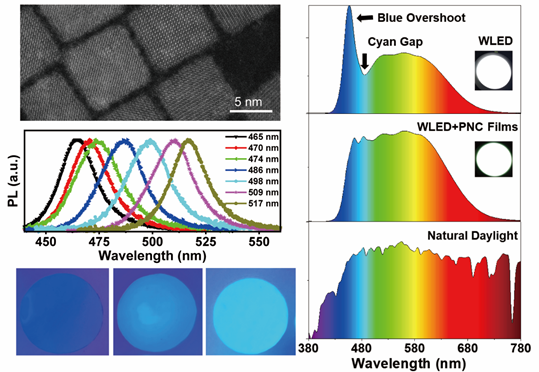The invention of the blue light emitting diode (LED), which propelled the development of the contemporary lighting and display industry, has been awarded the 2014 Nobel Prize in Physics. Solid-State white LEDs enjoy the reputation of "fourth generation light source". Compared with traditional incandescent lamp, fluorescent lamp and high-pressure gas discharge lamp, LEDs have the advantages of high efficiency, energy saving and environmental protection, long life, safety and reliability, and is considered as a new generation of environmental protection and energy saving light source in the 21st century. In 2020, China's LEDs market will exceed 100 billion US dollars. LEDs have penetrated into various fields of human life, and the proportion of people exposed to LED light environment is even far higher than that of natural light. However, LEDs, which offer many advantages over natural light, pose profound risks to human health.
At present, the most commonly used scheme for LED lighting is still InGaN blue LED chip (440-460 nm) and YAG yellow phosphors (520-700 nm) to produce white lighting. This scheme results in a "blue overshoot" in the 440-460 nm range and a "cyan gap" in the 470-520 nm range (Figure 1). Recent studies have shown that excessive exposure to intense blue light at 440-460 nm can increase optical damage to the human eye and lead to psychological problems such as depression. Studies have also shown that the "cyan gap" centered on 478 nm will affect human circadian rhythm, rod cell health, and induce myopia. Therefore, the ideal artificial light source is to mimic natural light, that is, to construct white light with uniform wavelength distribution by efficient luminescent devices in the 380-780 nm region.
In order to achieve the next generation of high-quality "full spectrum" solid-state white lighting, the current challenge is to develop materials that efficiently absorb "overshoot blue light" between 440 and 460 nm. At the same time, the development of fluorescent materials emitting cyan between 470 and 520 nm to compensate for the "cyan gap" is also crucial for healthy lighting. In addition, materials that emit cyan (470-520 nm) are particularly important for underwater communications, because light in this wavelength range is much less attenuated in water than other wavelengths. Therefore, it is of great significance to develop "full spectrum" lighting lamps that can "move mountains and fill oceans", that is, solve the two major industry pain points of "blue overshoot" and "cyan gap" at the same time.
Professor Zhengtao Deng and his team from the School of Engineering and Applied Science of Nanjing University have been committed to the basic research and industrial application of new perovskite quantum dot materials for many years. Especially in the direction of white LEDs, new progress has been made in improving the performance and stability of luminescent materials in view of the bottleneck problem in the practical application, such as: J. Phys. Chem. Lett. 2023, 14, 2006; Nanoscale. 2023, 15, 1661; Chem. Eur. J. 2023, 29, e202202675. In the current work, using quaternary ammonium as a single ligand, the team synthesized a series of bright and stable polymer-encased zinc-doped cesium-lead-chloro-bromine perovskite quantum dots, which can achieve efficient absorption in the blue light range of 440-460 nm and efficient emission in the blue light range of 470-520 nm. At the same time, the color conversion optical films prepared by the material shows good stability of strong light irradiation resistance, water/oxygen resistance and high temperature resistance, and the cost is relatively low. The 370 nm UV chip excited white light device and 455 nm blue light chip excited white light device constructed by this team show uniform distribution of white light and low brightness loss, indicating that this kind of color conversion optical films can effectively solve the two bottlenecks of "blue overshoot" and "cyan gap" in current lighting fixtures. The team expects that this research will lay the foundation for the application of polymer-coated halide perovskite color converters in the next generation of "full spectrum" natural-light mimics lighting.
Related results are presented on March 4, 2023 under the "Polymer-Coated Halide Perovskite Color Converters to Overcome Blue Overshoot and Cyan Gap of White Light-Emitting Diodes "published online in Advanced Functional Materials, an internationally renowned journal of materials science (impact factor: 19.924).

Figure 1: Scanning transmission electron microscope image, photoluminescence (PL) emission spectra of a series of zinc doped CsPbBrxCl3–x perovskite quantum dot samples, fluorescence images of three cyan emissive polymer-coated halide perovskite quantum dots color conversion film samples, and the emission spectra of a typical blue LED excited white lamp, and emission spectra of a white lamp using three color conversion optical films, and natural light spectra. As can be seen from the above, the emission spectrum of the lamp using the films presents a smooth, uniform and continuous distribution of the spectrum, and there is no "blue overshoot" and "cyan gap", which is close to natural light.
This work was supported by the National Natural Science Foundation of China (22075129) and the Technology Development Projects of Nanjing University (2022200996, 2021200077).
The link of the paper: https://onlinelibrary.wiley.com/doi/10.1002/adfm.202300583

